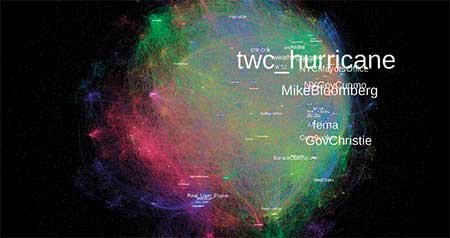News
The information presented on this page may be outdated. It may refer to situations which have changed or people who are no longer affiliated with the university. It is archived as part of Mississippi State University's history.
MSU researchers examine Twitter use during major weather events

Two Mississippi State researchers continue work on a two-year study of how social media may be better applied during extreme weather events that disrupt normal communication channels. (Photo By: Submitted)
10/27/2015
By: Vanessa Beeson
The investigation by John F. Edwards and Somya Mohanty began in the aftermath of Hurricane Sandy, the deadliest and most destructive storm of the 2012 Atlantic season and second-costliest hurricane in United States history.
As New England residents there were rebuilding their communities, the two university scientists began examining social media postings from the affected area to see if there might be better ways to improve communication.
Edwards is an associate research professor and Mohanty is an assistant research professor at MSU's nationally recognized Social Science Research Center. Both also are research scientists with the campus-based Mississippi Agricultural and Forestry Experiment Station.
"We wanted to identify and quantify relevant social media messages so that we could evaluate what was happening before, during and after the hurricane," Mohanty said.
Their project was part of the $1.8 million Coastal Storm Awareness Program, a collaboration among the states of New York and New Jersey and the Connecticut Sea-Grant Programs and National Oceanic and Atmospheric Administration. Federal funding through the Disaster Relief Act of 2013 made available more than $1.4 million for this and nearly a dozen other social science research projects focusing on ways to improve community understanding and response to coastal storm hazard information.
Three components of the MSU project included:
- A general population survey of the coastal counties affected by Sandy;
- Social-data analysis of Twitter messages before, during and after the storm; and
- Development of a Twitter-based, bi-directional software application to capture real-time images shared during the natural disaster.
They began by identifying prominent Twitter users and the flow of storm-related information throughout the network. Word collation maps were built to determine which words were used the most in relation to the event. Finally, overall sentiment—whether tweets were positive or negative in content—was assessed, with geotags to provide the real-time locations from which the tweets emanated.
"We built an artificial intelligence-based machine learning model which determined baseline emotions of a particular user group and identified if that group is feeling happy or sad by aggregating all of the messages being shared within the particular group," Mohanty said. "We identified positive emotion prior to the hurricane and negative emotion during the hurricane."
With the information, they successfully designed and developed a bi-directional system for use in the future. Tweets posted about such things as flood damage, downed trees and power outages can be made immediately available to emergency responders.
The system also enables data analysts by SSRC-trained researchers who can review each tweet's relevancy and verify its geo-referenced location in about 30 seconds. From there, the emergency responders can take action on the verified tweets and communicate directly with the Twitter user who may be in harm's way.
"We can process both text and images," Edwards said. "Since the images are in real-time, they provide emergency managers with a ground-level view of the weather conditions and damage long before first responders can reach the area.
"Regarding the processing of textual data, we identified over 500 people who used Twitter to cry for help during Hurricane Sandy," he continued. "During a weather-related disaster, many people lose their voice connection through their cellphones, but are still able to send out a tweet."
For Edwards, the MSU project has had a very personal aspect. He is a former New Orleans, Louisiana, resident whose family lost a home, automobile and boat to Hurricane Katrina.
As more and more people now look to social media as a preferred communication mode during disasters, he and Mohanty expressed hope their work can enable first-responders and emergency managers to better utilize every communication forum to better serve and protect the public in the face of danger.
For more on MSU's Social Science Research Center, visit www.ssrc.msstate.edu; the Mississippi Agricultural and Forestry Experiment Station, www.mafes.msstate.edu.
View More News